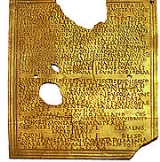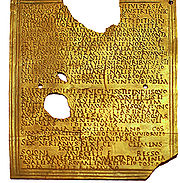
Military diploma
Encyclopedia

Roman citizenship
Citizenship in ancient Rome was a privileged political and legal status afforded to certain free-born individuals with respect to laws, property, and governance....
from the emperor as reward for service.
The diploma was a notarised copy of an original constitutio (decree) issued by the emperor in Rome, listing by regiment (or unit) the eligible veterans. The constitutio, recorded on a large bronze plate, was lodged in the military archive at Rome (none such has been found; presumably they were melted down in later times).
History
Diplomas were issued during the PrincipatePrincipate
The Principate is the first period of the Roman Empire, extending from the beginning of the reign of Caesar Augustus to the Crisis of the Third Century, after which it was replaced with the Dominate. The Principate is characterized by a concerted effort on the part of the Emperors to preserve the...
period (52-284 AD) to retiring veterans who had served in those corps of the Roman armed forces which enlisted peregrini
Peregrinus (Roman)
Peregrinus was the term used during the early Roman empire, from 30 BC to 212 AD, to denote a free provincial subject of the Empire who was not a Roman citizen. Peregrini constituted the vast majority of the Empire's inhabitants in the 1st and 2nd centuries AD...
, that is, inhabitants of the Roman empire who were not Roman citizens (the vast majority of the empire's population in the 1st and 2nd centuries). Such corps were: the auxilia; Roman navy
Roman Navy
The Roman Navy comprised the naval forces of the Ancient Roman state. Although the navy was instrumental in the Roman conquest of the Mediterranean basin, it never enjoyed the prestige of the Roman legions...
, the Praetorian Guard
Praetorian Guard
The Praetorian Guard was a force of bodyguards used by Roman Emperors. The title was already used during the Roman Republic for the guards of Roman generals, at least since the rise to prominence of the Scipio family around 275 BC...
's cavalry (equites singulares Augusti
Equites singulares Augusti
The equites singulares Augusti during the Principate period of imperial Rome. Based in Rome, they escorted the Roman emperor whenever he left the City on campaign or on tours of the provinces.The regiment was reconstituted in the late 1st century AD as a milliary ala, under the command of a...
); and the cohortes urbanae
Cohortes urbanae
The cohortes urbanae of ancient Rome were created by Augustus to counterbalance the enormous power of the Praetorian Guard in the city of Rome and serve as a police force...
(the City of Rome's public-order battalions).
The first known diploma dates from AD 52, under emperor Claudius
Claudius
Claudius , was Roman Emperor from 41 to 54. A member of the Julio-Claudian dynasty, he was the son of Drusus and Antonia Minor. He was born at Lugdunum in Gaul and was the first Roman Emperor to be born outside Italy...
(r. 41-54), who appears to have regularised the practice of granting Roman citizenship to non-citizen auxiliaries after 25 years' service (26 in the navy).
Diplomas were not normally issued to discharged legionaries, as the legion
Roman legion
A Roman legion normally indicates the basic ancient Roman army unit recruited specifically from Roman citizens. The organization of legions varied greatly over time but they were typically composed of perhaps 5,000 soldiers, divided into maniples and later into "cohorts"...
s recruited Roman citizens only. However, legionary diplomas were exceptionally issued after the Civil War of 68/69 AD
Year of the Four Emperors
The Year of the Four Emperors was a year in the history of the Roman Empire, AD 69, in which four emperors ruled in a remarkable succession. These four emperors were Galba, Otho, Vitellius, and Vespasian....
. As an emergency measure, 2 new legions, the I and II Classica (later reconstituted and renamed as I
Legio I Adiutrix
Legio prima Adiutrix , was a Roman legion formed in 68, possibly by Galba under orders of Nero. The last record mentioning the Adiutrix is in 344, when it was stationed at Brigetio , in the Roman province of Pannonia...
and II Adiutrix
Legio II Adiutrix
Legio secunda Adiutrix , was a Roman legion levied by emperor Vespasian in 70, from Roman navy marines of the classis Ravennatis. There are still records of II Adiutrix in the Rhine border in the beginning of the 4th century...
, respectively) were formed mainly from naval marines, many of whom did not hold citizenship. At the end of the crisis, these were all awarded Roman citizenship.
In 212, the Constitutio Antoniniana
Constitutio Antoniniana
The Constitutio Antoniniana was an edict issued in 212 AD, by the Roman Emperor Caracalla...
, issued by the emperor Caracalla
Caracalla
Caracalla , was Roman emperor from 198 to 217. The eldest son of Septimius Severus, he ruled jointly with his younger brother Geta until he murdered the latter in 211...
, granted Roman citizenship to all the inhabitants of the empire, thus ending the second-class peregrini status. This made military diplomas largely redundant, and indeed the last known auxiliary diplomas date from AD 203. But diplomas for service in the navy, Praetorian Guard
Praetorian Guard
The Praetorian Guard was a force of bodyguards used by Roman Emperors. The title was already used during the Roman Republic for the guards of Roman generals, at least since the rise to prominence of the Scipio family around 275 BC...
cavalry and the cohortes urbanae continued to be issued until the late 3rd century. This might be explained by the fact that barbari (foreigners from outside the Roman empire) were still recruited for those units.
Rights granted
The veteran was granted Roman citizenship, which carried important legal and fiscal advantages, including exemption from the poll taxPoll tax
A poll tax is a tax of a portioned, fixed amount per individual in accordance with the census . When a corvée is commuted for cash payment, in effect it becomes a poll tax...
(tributum capitis) payable by all non-citizen subjects of the empire. Citizenship was also granted to the veteran's natural children, but not to his female partner. Until ca. 140, all children born to the veteran during his term of service were eligible. After that date, it appears that the grant was restricted to children born after the veteran's discharge (unless the veteran had registered children born before his enlistment). This seemingly retrogressive step has been doubted by some historians, and it is possible that the available evidence is garbled.
Until the time of emperor Septimius Severus
Septimius Severus
Septimius Severus , also known as Severus, was Roman Emperor from 193 to 211. Severus was born in Leptis Magna in the province of Africa. As a young man he advanced through the customary succession of offices under the reigns of Marcus Aurelius and Commodus. Severus seized power after the death of...
(r. 197-211), serving soldiers were legally prohibited to marry. In practice, many formed stable relationships with local women and brought up families. Diplomas retrospectively regularised such unions by granting the discharged veteran, in addition to citizenship, the right of connubium ("inter-marriage"), which was necessary as Roman citizens were not legally permitted to marry non-citizens (unless the latter possessed "Latin Rights").
An exceptional constitutio of emperor Hadrian (r. 117-38) is known from 3 diplomas, which granted citizenship to the beneficiaries' parents and siblings, in addition to their children.
Description
The diploma consisted of two bronze tablets hinged together. Inscriptions would be engraved on each side of both plates. The full text of a diploma was engraved on the outer side of the so-called tabula 1, while the outer side of tabula 2 displayed the names of 7 witnesses, their seals covered and protected by metal strips (such seals have rarely survived, being of organic material). The text of tabula 1 was reproduced exactly on the two inner sides. The plates would then be folded shut and sealed together, so that the external inscription would be legible without breaking the seals. The internal inscription was the official notarised copy of the text on the constitutio published in Rome. The double-inscription and seals were presumably to prevent forgery or alteration.In a likely scenario, the holder would take the sealed diploma to the province or civitas (city/county) where he intended to live in retirement. He would then present the diploma to the keeper of archives either at the provincial governor's headquarters (or perhaps at his local civitas offices). The archivist could break the seals and check that the data on the internal inscription matched the external one. If all was in order, he would then enter the diploma-holder's name onto the register of resident Roman citizens.
Research significance
Over 800 diplomas from the Principate have been found and over 650 published (although the majority have survived in only fragmentary form). This constitutes a rare corpus of Roman documentary material, whose survival is due to their being made of metal, rather than bio-degradable material such as papyrus, wood or wax. A particular advantage of diplomas for historians is that they are dated. The date of the constitution was entered as the year of the emperor's tribunicia potestas; while the date of issue of the notarised copy (diploma) was given as the day of the month and the names of the ConsulsRoman consul
A consul served in the highest elected political office of the Roman Republic.Each year, two consuls were elected together, to serve for a one-year term. Each consul was given veto power over his colleague and the officials would alternate each month...
currently in office (resulting in diplomas being an important source for the names of suffect-Consuls). As these documents also list the name of the provincial governor, they provide valuable data on senators' career-paths. In addition, diplomas usually record the names of several auxiliary units which served in the same province at the same time, as they were normally issued in batches. Thus a single diploma may yield the names of as many as 25 units included in the same constitution, critical data on the deployment of auxiliary units in the various provinces of the empire at different times. Constitutions are also known just for individual units, even individual veterans.
The following information on the beneficiary was usually recorded in the diploma: beneficiary's regiment, regimental commander's name, beneficiary's military rank, name of beneficiary, name of beneficiary's father and origin (nation, tribe or city); name of beneficiary's wife and name of her father and origin; and names of children granted citizenship.
Primary sources
- Corpus Inscriptionum Latinarum (CIL) Band XVI and Supplement
- Roman Military Diplomas (RMD, Margaret Roxan, Paul Holder) Vols. I-V
Secondary sources
- Werner Eck, Hartmut Wolff (Hrsg.): Heer und Integrationspolitik. Die römischen Militärdiplome als historische Quelle. Böhlau, Köln [u.a.] 1986. (Passauer historische Forschungen, 2) ISBN 3-412-06686-9
- "Die Rolle des Militärs für den sozialen Aufstieg in der römischen Kaiserzeit" (Barbara Pferdehirt)Mainz, RGZM (2002) 2) ISBN 3-88467-069-7
- "Römische Militärdiplome und Entlassungsurkunden in der Sammlung des Römisch-Germanischen Zentralmuseums" (Barbara Pferdehirt) Mainz, RGZM (2004) 2) ISBN 3-88467-086-7

